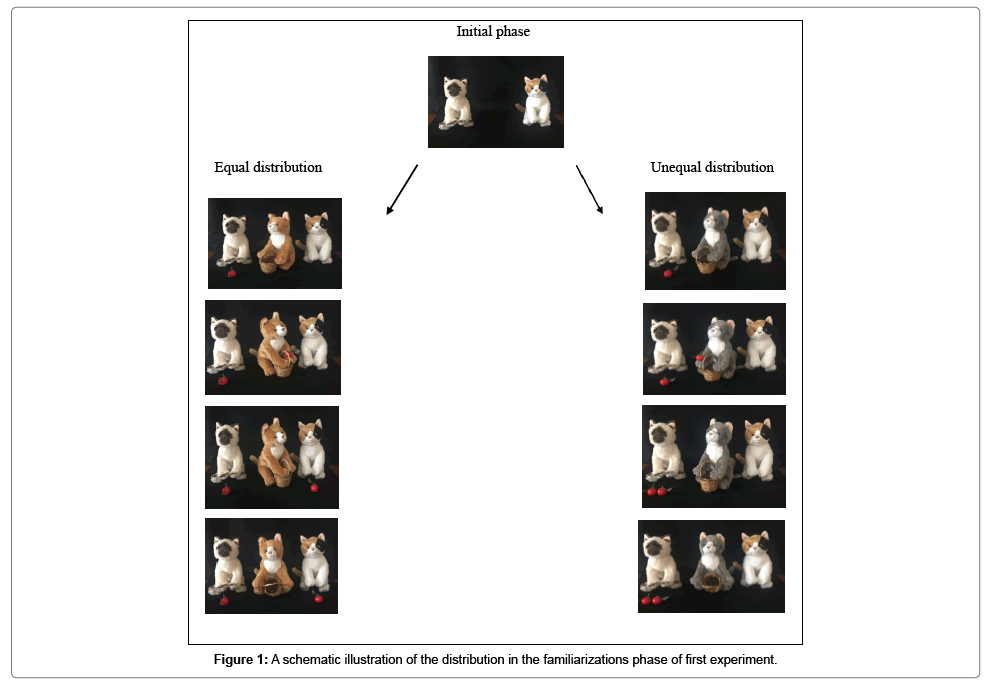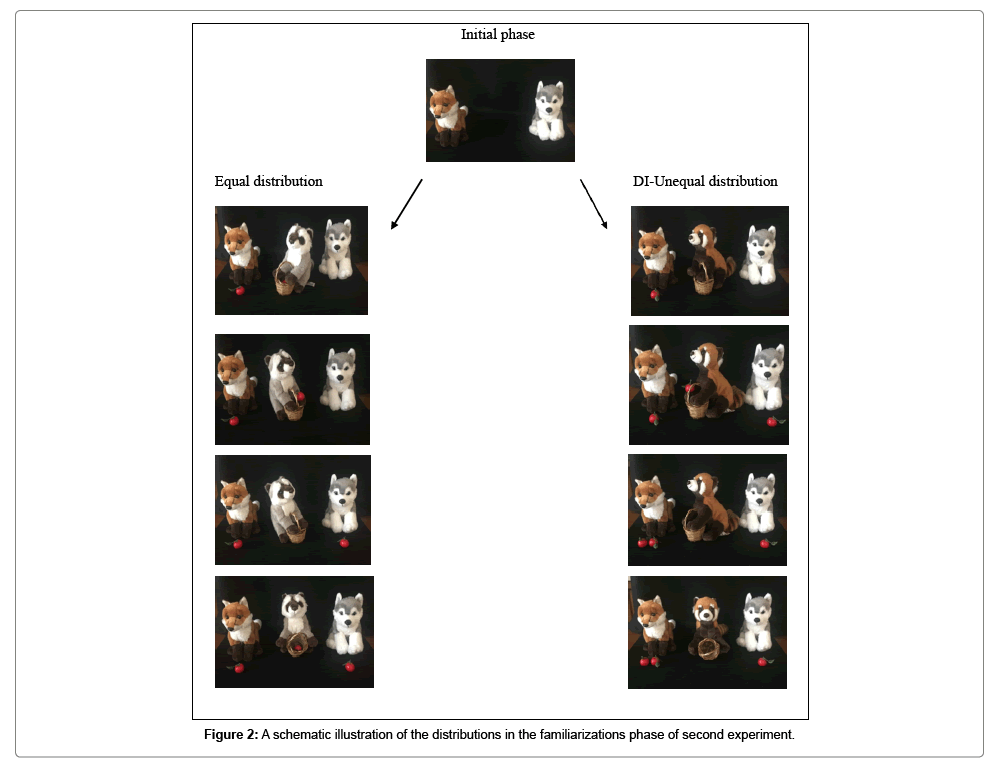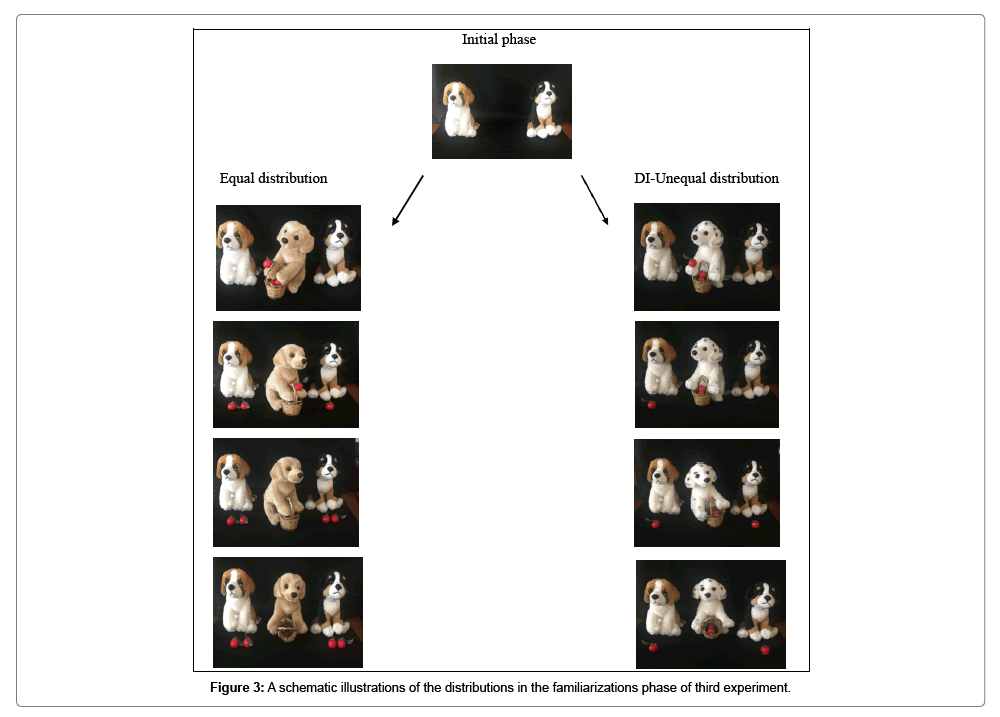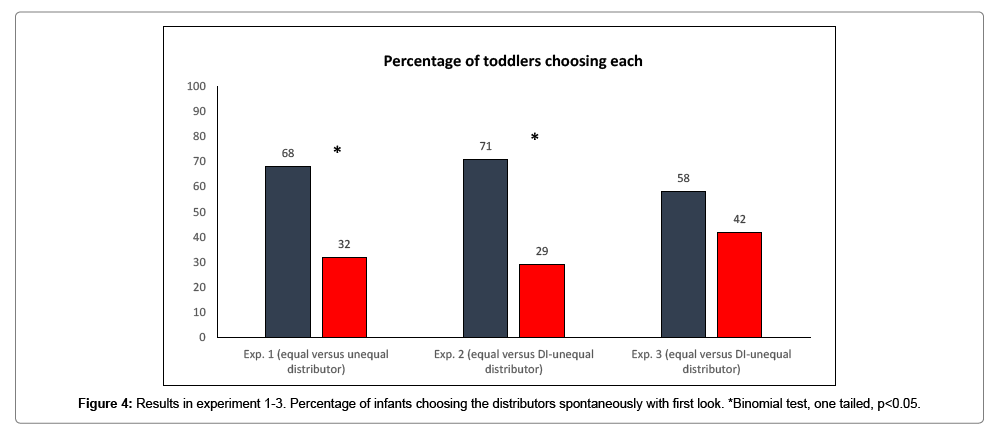Toddlers' Spontaneous Reactions to Inequality in Distributive Actions
Received: 28-Jun-2018 / Accepted Date: 24-Jul-2018 / Published Date: 31-Jul-2018 DOI: 10.4172/2375-4494.1000379
Abstract
This study investigates a spontaneous preference for an equal distribution of resources. Toddlers are presented with real life events followed by a verbal test question. In the first experiment one of the distributors (the ‘equal’) gives one cherry to each receiver, while the other one (the ‘unequal’) gives both cherries to just one of the two receivers. In the second a distributor (the ‘equal’) gives one cherry to each receiver, and left one for himself, while the other (the ‘DI-unequal’) gives two cherries to one receiver and one cherry to another receiver, creating a state of disadvantageous inequity. In the third experiment a distributor (the ‘equal’) gives two cherries to each receiver over while the other (the ‘DI-unequal’) gives one cherry to each receiver and keeps two to themselves, creating a state of disadvantageous inequity where the distributor has more than receivers. Toddlers show a spontaneous preference for an equal distributor of resources versus an unequal distributor and insensitivity to the contents of the distributor’s basket.
Keywords: Distributive actions; Inequity aversion; Disadvantageous inequity; Moral development
Introduction
Sharing resources with others is an important feature of social life and people have expectations concerning how resources should be distributed, according to moral principles and social theories of justice [1,2].
New research on the development of moral cognition provides important insight into the origins of distributive justice, given that recent work has demonstrated that infants have a sophisticated understanding of fairness in evaluations of distributive actions [3]. By 10 months infants expect agents to perform equal distributions and within the second year of life infants possess rich knowledge about distributive justice and resources distributions, prefer fair agent to unfair ones, and associate praise or admonishment to fair or unfair distributors [4-9]. From the second year of life children expect agents to treat others in distributive actions in accord with their deservingness [6,10].
Several studies have focused on one type of fairness that concerns the inequity aversion, that refers to people’s tendency to respond negatively to being given too much (advantageous inequity, AI) or too little (disadvantageous inequity, DI) of a reward and therefore attempt to correct inequity [11]. Developmental studies have found that children become upset when others receive more than them and reduce inequity by sharing resources with others who have less [12,13]. Shaw and Olson [14] found that 6 to 8-year-old children would rather throw a resource in the trash than distribute unequally. In a recent study 4- and 6-years-olds showed a stronger inequity aversion to DI than to AI, they cared more about fairness when they would be disadvantaged by inequity conditions [15]. The difference between DI and AI was not significant in 8-years-olds, suggesting an emergence of other-oriented and concern as children get older. On preschool age, a previous research has demonstrated that even 3-year-old children respond negatively to others throwing away a third party’s resources [16]. Recently also some researchers found that 3- and 4-year-old children not only objected when they received less than a collaborative partner but also sacrificed to equalize when they received more [17].
In the current study 2- year-olds were recruited because a sense of fairness has been shown to emerge before this developmental period [6,8] and some works found in toddlers some expectations for fair distributive actions [5,7,10]. We recorded toddlers’ looking behaviour and we measured initial look which is the first look that the participants made towards one of the two distributors after test question, as in previous studies [18,19].
Whereas infants possess a sense of fairness, it is unknown whether toddlers are sensitive. We investigate in 26-month-olds a spontaneous preference for an equal distributor versus an unequal distributor that gives resources unequally (experiment 1) and too little (disadvantageous inequity) (experiment 2 and 3).
Experiment 1
Participants
Thirty-two toddlers participated, with a mean of 28 months and 4 days (11 females; range=18 months 5 days through 34 months 21 days).
Materials and procedure
Infants were tested in a quiet room of day nurseries in Catania (Italy), after some days of familiarization with the experimenter in their classroom. Each toddler was seated on the educator’s lap, 50 cm from a wooden theatre (80cm X 60 cm), while the experimenter was behind a black curtain and controlled the event presentation. A camera was posted behind the theatre to record infants’ face during the stimuli presentation. Each child was presented with two familiarization trails and one test trial involving live presentation of stimuli and one test trial on a choice. In both familiarization trials, an attractive sound was used at the beginning of each trial and at the end of each distribution. On each familiarization trial, two different triplets of animals were shown with two cherries. Each familiarization trial started with a sound and then two receivers entered the scene, one by one, moved a little toward the centre and then they resting one on each side of the screen. Later another animal entered in the scene from the centre with a basket containing two cherries. This was described as distributor possessing the two cherries taken from home, while the other two played the role of receivers. One of the distributors (the ‘equal’), gave one cherry to each receiver, while the other one (the ‘unequal’) gave both cherries to just one of the two receivers (Figure 1). Following the two familiarization trials, the experimenter put the two distributors in front of the child and after 6 second he asked: “Look! Who do you like?”.
Results
To assess toddlers’ preferences, we coded the first look children made after the test question. Toddlers looked first at the fair distributor 22 out of 32 times (68%), (p<0.05, binomial test, two-tailed). These results reveal a preference for agent that performed an equal distribution of resources. First looks on test trials were coded independently by one experimenter and by an independent judge who was blind to the fairness of distributors. For looking times, the inter-judge reliability was very high (Pearson’s r=0.99).
Experiment 2
Participants
Twenty-eight toddlers participated, with a mean of 28 months and 12 days (10 females; range=18 months 5 days through 34 months 21 days). Three participants were excluded because two did not follow familiarization events and one cried during test trial.
Materials and procedure
Infants were tested on a fairness task 2 (FT2) and the procedure was as in the first experiment. Toddlers were given two similar trials. On each trial, 2 different triplets of animals were shown with three cherries. One of the animals on each tray (i.e., the distributor) was described as possessing the three cherries taken from home, while the other two played the role of receivers. One of the distributors (the ‘equal’ one), gave one cherry to each receiver, and left one for himself. The other one (the ‘DI-unequal’ distributor) gave two cherries to one receiver and one cherry to another receiver (Figure 2).
Results
To assess toddlers’ preferences, we coded the first look children made after the test question. Toddlers looked first at the ‘equal’ distributor 20 out of 28 times (71%), (p<0.05, binomial test, twotailed). These results reveal a preference for the distributor that gives one cherry to each receiver, and left one for himself.
Experiment 3
Participants
Thirty-one toddlers participated, with a mean of 26 months and 25 days (11 females; range=18 months 5 days through 34 months 21 days). One participant was excluded because he cried during familiarization events.
Materials and procedure
Infants were tested on a fairness task 3 (FT3) and the procedure was as in the first experiment. Toddlers were given two similar trials. On each trial, 2 different triplets of animals were shown with four cherries. One of the animals on each tray (i.e., the distributor) was described as possessing the four cherries taken from home, while the other two played the role of receivers. One of the distributors (the ‘equal’ one) gave two cherries to each receiver. The other one (the ‘DI-unequal’ distributor) gave one cherries to each receiver and left two cherries for himself (Figure 3).
Results
To assess toddlers’ preferences, we coded the first look children made after the test question. Toddlers looked first at the equal distributor 18 out of 31 times (58%), (p>0.05, binomial test, two-tailed) (Figure 4).
Discussion
In the two first experiments we found a toddlers’ preference for equal distribution of resources measured by a spontaneous measure (first look). In the first experiment 28-mounths-olds show a gaze related preference for an equal distributor over an unequal distributor. Our findings are coherent with results reported in precedent developmental researches on infants [6,8] and on toddlers [5,7,10]. In the second experiment we found that toddlers show a gaze related preference for the distributor that gives one cherry to each animal and keeps one to themselves over the unequal distributor that gives two cherries to one receiver and one cherry to other receiver. They preferred equal distributor rather of DI_unequal distributor, but toddlers may not have been sensitive to whether the distributor was disadvantaged. Insensitivity to the contents of the distributor’s basket explains the lack of preference in the third experiment since, both the equal and DIunequal puppets distribute resources equally to the receivers.
In the third experiment toddlers tend to prefer the distributor that gives two cherries to each receiver over the other the gives one cherry to each receiver and keeps two to themselves, creating a state of disadvantageous inequity where distributor has more than others. One explanation is that toddlers are explicitly socialized and instructed in nursery to make outcomes equitable between receivers. In both distributions (‘equal’ and ‘DI-unequal’) the two recipients receive equally resources (2-2; 1-1), so they played fair to give cherries equally to two recipients.
Taken together, our results demonstrate that 28-mounth-olds prefer spontaneously an equal distributor versus an unequal distributor and the findings are coherent with results of some recent works on childhood and on infancy [6,8,15].
The results could suggest that 28-month-olds have learned about the experience of having things like cherries and being happy, and equal distributions would engender happiness compared to negative reactions in the event in which some characters get less than others [20-22]. This is a practical social based on expectations from experience of unequal distribution and this could be viewed as having a moral dimension because it does involve how others are treated. This early practical emotional understanding could be an important step in development of moral cognition.
One limitation of the present study derives from the small sample size and the large age range. Future works could extend these results by presenting allocation task with AI and DI condition in earlier age to investigate an early to inequity aversion.
References
- Hsu M, Anen C, Quartz SR (2008) The right and the good: distributive justice and neural encoding of equity and efficiency. Sci 320: 1092-1095.
- Tomasello M (2016) A natural history of human morality. Harvard University Press.
- Tomasello M, Vaish A (2013) Origins of human cooperation and morality. Ann Rev Psychol 64: 231-255.
- Meristo M, Strid K, Surian L (2016) Preverbal Infants' Ability to Encode the Outcome of Distributive Actions. Infancy 21: 353-372.
- Schmidt MF, Sommerville JA (2011) Fairness expectations and altruistic sharing in 15-month-old human infants. PloS one 6: e23223.
- Sloane S, Baillargeon R, Premack D (2012) Do infants have a sense of fairness? Psychol sci 23: 196-204.
- Sommerville JA, Schmidt MF, Yun JE, Burns M (2013) The development of fairness expectations and prosocial behavior in the second year of life. Infancy 18: 40-66.
- Geraci A, Surian L (2011) The developmental roots of fairness: Infants’ reactions to equal and unequal distributions of resources. Dev Sci 14: 1012-1020.
- DesChamps TD, Eason AE, Sommerville JA (2016) Infants associate praise and admonishment with fair and unfair individuals. Infancy 21: 478-504.
- Surian L, Franchin L (2017) Toddlers selectively help fair agents. Frontiers in Psychology 8: 944.
- Fehr E, Schmidt KM (1999) A theory of fairness, competition, and cooperation. Â Quart J Econ 114: 817-868.
- Blake PR, Rand DG (2010) Currency value moderate’s equity preference among young children. Evol Hum Behav 31: 210-218.
- Fehr E, Bernhard H, Rockenbach B (2008) Egalitarianism in young children. Nature 454: 1079-1083.
- Shaw A, Olson KR (2012) Children discard a resource to avoid inequity. J Exp Psychol: Gen 141: 382-395.
- Qiu XQ, Yu J, Li T, Cheng N, Zhu L (2017) Children’s Inequity Aversion in Procedural Justice Context: A Comparison of Advantageous and Disadvantageous Inequity. Frontiers Psychol 8: 1855.
- Rossano F, Rakoczy H, Tomasello M (2011) Young children’s understanding of violations of property rights. Cognition 121: 219-227.
- Ulber J, Hamann K, Tomasello M (2015) How 18-and 24-month-old peers divide resources among themselves. J Exp Child Psychol 140: 228-244.
- Vernetti A, Smith TJ, Senju A (2017) Gaze-contingent reinforcement learning reveals incentive value of social signals in young children and adults. Proc R Soc B 284: 20162747.
- Wang Q, Bolhuis J, Rothkopf CA, Kolling T, Knopf M et al., (2012) Infants in control: rapid anticipation of action outcomes in a gaze-contingent paradigm. PloS one 7: e30884.
- McAuliffe K, Raihani NJ, Dunham Y (2017) Children are sensitive to norms of giving. Cognition.
- Southgate V, Senju A, Csibra G (2007) Action anticipation through attribution of false belief by 2-year-olds. Psychol Sci 18: 587-592.
- Smith CE, Blake PR, Harris PL (2013) I should but I won’t: Why young children endorse norms of fair sharing but do not follow them. PloS one 8: e59510.
Citation: Geraci A, Nuovo SD (2018) Toddlers’ Spontaneous Reactions to Inequality in Distributive Actions. J Child Adolesc Behav 6: 379. DOI: 10.4172/2375-4494.1000379
Copyright: © 2018 Geraci A, et al. This is an open-access article distributed under the terms of the Creative Commons Attribution License, which permits unrestricted use, distribution, and reproduction in any medium, provided the original author and source are credited.
Select your language of interest to view the total content in your interested language
Share This Article
Open Access Journals
Article Tools
Article Usage
- Total views: 5044
- [From(publication date): 0-2018 - Nov 20, 2025]
- Breakdown by view type
- HTML page views: 4049
- PDF downloads: 995




